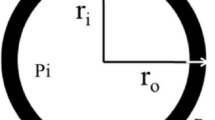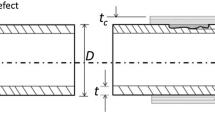Abstract
Corroded subsea pipe repaired with composite material is more and more used because of its low cost, simple process and short time, but the repair effect will be affected by factors such as temperature and material degradation. To study the law of the effect, the finite element method is used to analyze ultimate loads on repaired pipe by considering the factors of temperature and material degradation. The results show that the ultimate yielding and bursting pressure decreases with the increase in temperature for both the defect pipe and repaired pipe under temperature and internal pressure. The ultimate pressures are larger when both ends of the pipe are fixed comparing with one end is free, but they also decrease faster as the temperature increases. Experiments show that elastic modulus and glass transition temperature of composite will decrease when exposed to prolonged seawater and high temperature. The degradation of composite repair layer performance has a great effect on the ultimate pressure of pipe, and the failure of the repair area will be caused under long-time harsh environment. In this paper, the design repair thickness of composite is obtained, which could improve the repair efficiency of corroded pipes and reduce cost as well.




















Similar content being viewed by others
References
Wang HQ (2014) Corrosion pipe repair technology. Oil Gas Field Surf Eng 33(8):109
Ma WF, Chen ZX, Luo JH (2011) Discussion about application of composite repair technique in pipeline engineering. International conference on advanced design and manufacturing engineering. Guangzhou, pp 185–188
Lu MX, Chen YF, Dong SH et al (2006) Pipe maintenance reinforcement technology and its development trend. City Gas 24(2):129–132
Michael BJ (2009) Mechanical damage in pipelines: final report. PHMSA, Washington, pp 13–15
Saeed N, Ronagh H, Virk A (2014) Composite repair of pipelines, considering the effect of live pressure-analytical and numerical models with respect to ISO/TS 24817 and ASME PCC-2. Compos B Eng 58(3):605–610
Shamsuddoha M, Islam MM, Aravinthan T et al (2013) Effectiveness of using fiber-reinforced polymer composites for underwater steel pipeline repairs. Compos Struct 100(5):40–54
Zou HX, Ma TX, Xie NN et al (2016) Simulation analysis of repairing defective pipe of aramid fiber composites. Oil Gas Storage Transp 35(11):1206–1211
Budhe S, Banea MD, Rohem NRF et al (2017) Failure pressure analysis of composite repair system for wall loss defect of metallic pipelines. Compos Struct 176:1013–1019
Botto D, Zucca S, Gola MM (2003) A methodology for on-line calculation of temperature and thermal stress under non-linear boundary conditions. Int J Press Vessels Pip 80(1):21–29
Liu JM, Zhang GW, Zhou GQ et al (2015) Numerical simulation analysis of thermal-structural coupling of high temperature gas pipes. Chin J Constr Mach 13(4):358–362
Abanilla MA, Li Y, Karbhari VM (2006) Durability characterization of wet layup graphite/epoxy composites used in external strengthening. Compos B Eng 37(2–3):200–212
Gu H (2009) Behaviours of glass fiber/unsaturated polyester composites under seawater environment. Mater Des 30(4):1337–1340
Siriruk A, Penumadu D (2014) Effect of sea water on polymeric marine composites//durability of composites in a marine environment. Springer, Netherlands, pp 129–142
Ruggieri C, Dotta F (2011) Numerical modeling of ductile crack expansion in high pressure pipelines with longitudinal flaws. Eng Struct 33(5):1423–1438
Sweeting RD, Liu XL (2004) Measurement of thermal conductivity for fiber-reinforced composites. Compos A 35(7):933–938
Joven R, A RD, et al (2012) Thermal properties of carbon fiber/epoxy composites with different fabric weaves. SAMPE international symposium proceedings
Kootsookos A, Mouritz AP (2004) Seawater durability of glass and carbon-polymer composites. Compos Sci Technol 64(10–11):1503–1511
Zhou J, Lucas JP (1999) Hygrothermal effects of epoxy resin. Part II: variations of glass transition temperature. Polymer 40(20):5513–5522
The American Society of Mechanical Engineers (2011) Repair and testing standard: ASME PCC-2-2011. ASME Publishing Services, New York, pp 139–171
Hammami A, Al-Ghuilani N (2004) Durability and environmental degradation of glass-vinylester composites. Polym Compos 25(6):609–616
Acknowledgements
The authors appreciated the reviewers’ constructive comments and detailed feedback for improving the manuscript. This research was supported by the National Natural Science Foundation of China (Grant number 51779266) and the National Key Research and Development Plan (Grant number 2016YFC0303705).
Author information
Authors and Affiliations
Corresponding author
Additional information
Publisher's Note
Springer Nature remains neutral with regard to jurisdictional claims in published maps and institutional affiliations.
About this article
Cite this article
Xin, J., Zhang, Y., Zhong, C. et al. Analysis of ultimate pressure of corroded subsea pipe repaired with composite considering temperature and material degradation. J Mar Sci Technol 25, 285–297 (2020). https://doi.org/10.1007/s00773-019-00647-y
Received:
Accepted:
Published:
Issue Date:
DOI: https://doi.org/10.1007/s00773-019-00647-y




